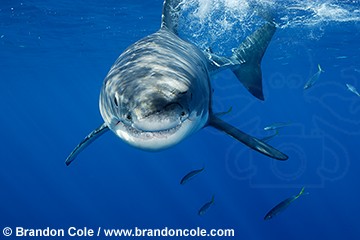|
photos of great
white sharks
To see more great white shark
pictures, click here
|

underwater stock photos of Great White Sharks, available for licensing |

Great White Shark pictures, including breaching from South Africa |

marine photograph of the dorsal fin which strikes fear into mankind |

dramatic Great White Shark images with impact for advertising |
|
common
name |
Great
White Shark, also called White Pointer |
| scientific
name |
Carcharodon
carcharias |
| range |
worldwide,
temperate and occasionally tropical |
viewing
hotspots |
South
Africa, South Australia, Guadalupe Is. Mexico |
| habitat |
primarily
coastal |
| size |
to
20 feet (6.5m), 7000 lbs. |
| diet |
pinnipeds
(seals and sea lions), fish |
| trivia |
far fewer
attacks on man than media portrays; serrated teeth; Megaladon ancestor
might have been 50' long; protected in some waters |
|
How we love our monsters.
Few creatures are as fascinating, or fearful, as the Great
White Shark, Carcharodon carcharias. The anti-hero in Jaws, stalker
of surfers and unsuspecting swimmers, it is a world famous
celebrity, though we know very little about its biology and
behavior. Some people swear never ever to enter the ocean because of
it, while others travel around the globe spending thousands of
dollars to dive with it.
One of the largest and most dangerous shark
species, it belongs to the family Lamnidae, the Mackerel Sharks.
Thick-bodied, torpedo-shaped, with a conical snout, soul-less black
eyes and a mouth full of large, triangular teeth, it has evolved
over millions of years to hold a position at the top of the food
chain. Unquestionably dangerous, it never-the-less does not deserve
its reputation as a ravenous man-eater. More people are bitten by
people each year than by "white death"; more hapless
humans are killed by falling vending machines. Statistically
speaking, great whites are not worth worrying about.
White sharks are not abundant anywhere.
They are most likely to be found in temperate coastal waters, often
around rocky reefs and kelp beds, and especially near seal and sea
lion rookeries. Adults feed primarily on such warm-blooded, fat-rich
marine mammals, though also dine on bottom fish, tuna, other sharks
and rays, and the odd sea bird, turtle, whale or dolphin. Carrion is
a particular favorite; a dead whale is an irresistible treat.
Juvenile white sharks eat primarily fish. In South Africa, great
whites have developed a special hunting technique, breaching clear
of the water in an extraordinary surprise attack on seal pups.
Females are sexually mature at
approximately 10 to 12 years old, and give birth to 7 to 9 live pups
approximately 4 feet (1.3) in length. With only four to six such
litters in a lifetime, this species is extremely vulnerable to
overfishing. Even though officially protected in a few places
including South Australia and South Africa, the future of the great
white is uncertain. They are still being killed by fishermen and
trophy hunters.
|
|
| KEYWORDS
great white shark, great white sharks, great, white, shark, sharks, white
pointer, white shark, white sharks, fish, Carcharodon carcharias,
elasmobranch, elasmobranchs,
breaching, jumping, attacking, behavior, dangerous, risky, risk, photo, photos, photograph, photographs,
picture, pictures, stock, photography, marine, underwater |
|